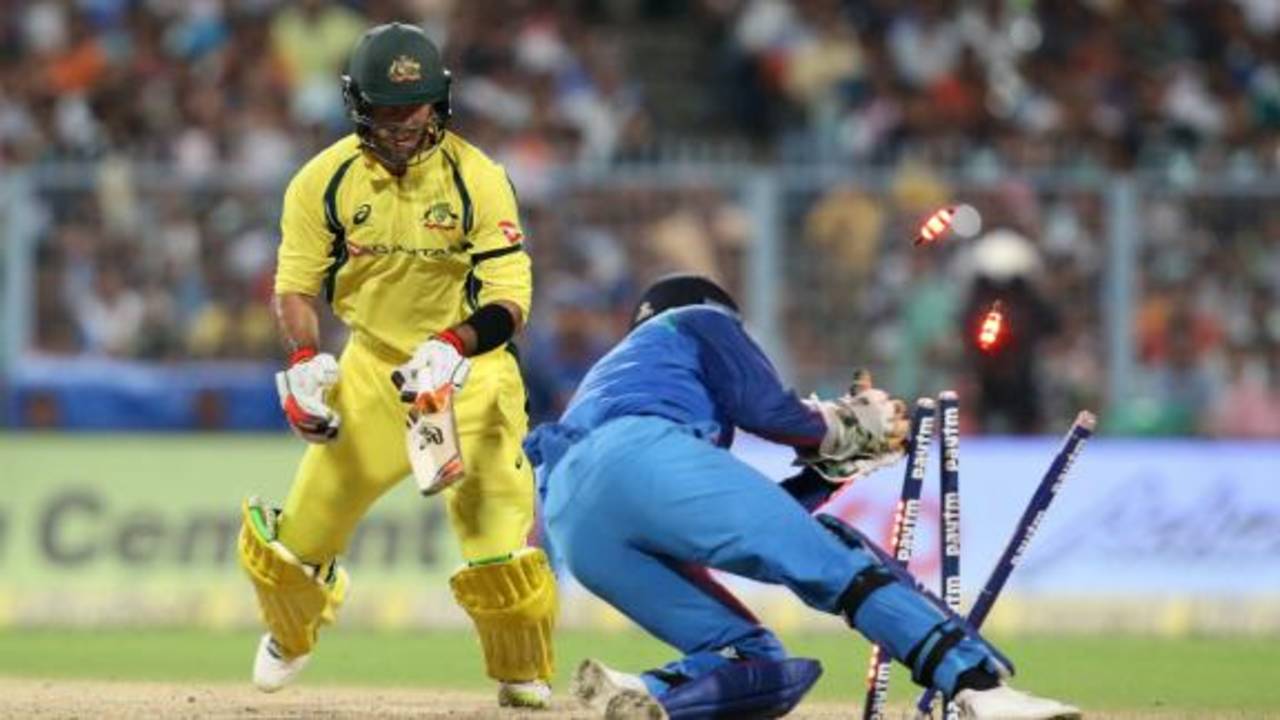Australia look to resolve batting woes to save series
The bowling attacks of both teams have done well in the series so far but the difference has been Australia's failure to execute with the bat
The Preview by Nikhil Kalro
23-Sep-2017
Big Picture
In 11 completed innings during Australia's previous ODI tour of India in 2013, 3569 runs were scored, at an average of 324.45 runs per innings. On this tour, 872 runs have been scored in two matches, including a 21-over innings in Chennai, an average of 218 per innings. If ODIs were a stock market, projected on a year-on-year graph, the batting standards would be the bull market and bowling, the not-so-scary bear. With the advent of T20s, that trend is changing. Bowlers are honing and executing their defensive skills better than ever before, and the balance between bat and ball is slowly being restored.
An example is India's bowling attack. All five bowlers are capable of bowling at any stage of an innings and can adapt their roles - holding an end up or attacking - to the situation of the match, the IPL contributing to this development. And Australia's batsmen have failed to raise their own game, particularly against wristspin. They have scored 339 runs against pace and spin in this series for 19 wickets, an average of 17.84 per wicket.
The same can be said of Australia's bowlers, who have not allowed a strong Indian batting line-up to cross 300 - a benchmark modern-day ODI total - in either game. In Chennai, they dominated the first half of their bowling innings, and in Kolkata, the second half. Both teams' bowling line-ups have delivered in tough bowling conditions, but the difference has only been Australia's failure to execute with the bat. A flat surface in Indore may help. A win for India, meanwhile, in addition to clinching the series, can help them climb to No. 1 on the ICC rankings for ODI teams.
Form guide
India WWWWW (last five completed matches, most recent first)
Australia LLLLL
Australia LLLLL
In the spotlight
Hardik Pandya may be having the best year of his life: another terrific IPL season, a sensational debut Test series and now an indispensable cog in India's limited-overs set-up. He has the attributes to be the seam-bowling allrounder India are yearning for. He is already one of the cleanest hitters in world cricket, he can hit 140 kmph and use the bouncer effectively. All those elements have already been seen in this series so far. Can he just build on that confidence?
While the rest have been plagued by inconsistency, Steven Smith and David Warner have carried Australia's batting on their backs over the past few years. Smith struck a measured half-century in Kolkata, while Warner has failed twice. Australia need them firing in Indore, not just for their runs, but also for the boost in morale they desperately need.
Team news
After another failure in Kolkata, will India persist with Manish Pandey? If not, KL Rahul may come in at No. 4.
India (probable): 1 Ajinkya Rahane, 2 Rohit Sharma, 3 Virat Kohli (capt), 4 Manish Pandey/KL Rahul, 5 Kedar Jadhav, 6 MS Dhoni (wk), 7 Hardik Pandya, 8 Bhuvneshwar Kumar, 9 Kuldeep Yadav, 10 Yuzvendra Chahal, 11 Jasprit Bumrah
On Saturday, Aaron Finch, recovering from a calf injury, batted in the nets for 20 minutes, testing shots off both feet, and running twos and threes between the wickets. Peter Handscomb also took the gloves during training. Both could come in at the expense of Hilton Cartwright and Matthew Wade, strengthening Australia's weaker suit, their batting. They may also consider bringing back wristspinner Adam Zampa for fingerspinner Ashton Agar on a batting-friendly surface.
Australia (probable): 1 David Warner, 2 Aaron Finch, 3 Steven Smith (capt), 4 Travis Head, 5 Peter Handscomb, 6 Glenn Maxwell, 7 Marcus Stoinis, 8 Pat Cummins, 9 Nathan Coulter-Nile, 10 Kane Richardson, 11 Adam Zampa/ Ashton Agar
Pitch and conditions
Short boundaries and a flat surface, that's how ODIs have been played in India for the last few years. The Holkar Cricket Stadium may provide the first 300-plus score of the series, maybe even two. Also in a first for the series, rain is not expected to intervene.
Stats and trivia
Quotes
"It's about that middle period, against the spinners, we have to look to rotate the strike, minimise damage and that's what you try and do in any one-day format, doesn't matter who is bowling."
David Warner on Australia's strategy against India in the middle overs
David Warner on Australia's strategy against India in the middle overs
"When you end up winning matches even after scoring 240-ish totals, you establish yourself as the No. 1 team."
Ajinkya Rahane on India's bowling prowess
Ajinkya Rahane on India's bowling prowess
Nikhil Kalro is a sub-editor at ESPNcricinfo


